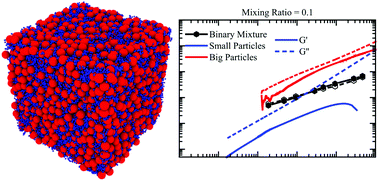Binary colloidal glasses: linear viscoelasticity and its link to the microscopic structure and dynamics
Abstract
We study the relation between the microscopic structure and dynamics and the macroscopic rheological response of glass-forming colloidal suspensions, namely binary colloidal hard-sphere mixtures with large size asymmetry (1 : 5) that span a large range of mixture compositions close to the glass transition. The dynamical shear moduli are measured by oscillatory rheology and the structure and dynamics on the single-particle level by confocal microscopy. The data are compared with Brownian Dynamics simulations and predictions from mode-coupling theory based on the Percus-Yevick approximation. Experiments, simulations and theory consistently observe a strong decrease of the intermediate-frequency mechanical moduli combined with faster dynamics at intermediate mixing ratios and hence a non-monotonic dependence of these parameters but a localization of the large particles which decreases monotonically as the fraction of small particles is increased. We find that the Generalized-Stokes Einstein relation applied to the mean square displacements of the two components leads to a reasonable estimate of the shear moduli of the mixtures and hence links the rheological response to the particle dynamics which in turn reflects the microscopic structure.



 Please wait while we load your content...
Please wait while we load your content...